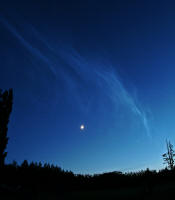
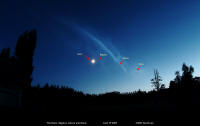 |
Moon, Regulus, Saturn, Venus - June 19, 2007 Out
on a field in Metchosin as the Sun faded we watched the Moon, Regulus,
Saturn and Venus pop in to view. It was a beautiful setting and just prior
to our viewing of the ISS and Shuttle the sky was covered in feathery
clouds. As a special treat while breaking down my telescope I looked up to
see an amazing fireball just above me (~11:45pm). It almost looked like a
bolt of lightning and I could see it slowing down and breaking up. |
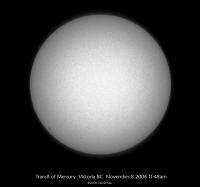
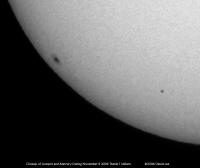 |
Transit of Mercury - Nov 8, 2006 This morning Joe
Carr and Guy Walton joined me at the parking lot near the machine shop to
view the Mercury transit. We had a perfect view except for the clouds and
occasional spots of rain. Just before the transit began the skies opened up
revealing the Sun. The views were still hazy but we imaged and view the
beginnings of the transit. Mercury is very tiny :-) but very visible.
Finally the clouds really set in and we had to call it a day.
AChannel arrived just as we were packing up and Joe gave them
an interview
(894k wmv, used with permission),
describing the event and a little PR for the society. Good interview.
Then it really started pouring so I had to grab everything and throw it in
the car. As I was packing Brenda arrived with lunch (Tim Horton's:
astronomer's choice). It was a short transit for us in Victoria, I hope
others in the group faired well and perhaps better :-)
Mount: Losmandy GM8
Telescope: Televue NP101is 540/5.4 with Powermate 2x
Effective Focal Length: 1080mm
Filtration: Baader Astrosolar Film
Camera: Fuji Finepix S2
ISO Sensitivity: 400
Exposure: 1/250 second |
 |
Comet Swan at Otter Point - Oct 30, 2006 It was a
great evening of imaging at Sandy Barta's Otter Point site. A little bit
cold for warm-blooded creatures but a far superior dark sky in spite of the
Moon hanging in the sky to the south. As night approached the constellation
Hercules was framed perfectly between the trees facing west. With the change
in daylight savings time it was dark by 6:30pm. Near 58-Epsilon Herculis was
the fuzzy ball called Comet Swan that we've been chasing from city skies.
I focused and start a number of 60 second frames. By 7:00pm Joe Carr had
arrived and set up ahead of me on the driveway. Many frames later we
were chilled popsicles and the Comet descended into the trees.
Telescope: Televue NP101is 540mm/5.4
Mount: Losmandy GM8
Camera: Fuji Finepix S2 Pro
Sensor ISO: 1600
Exposures: Aligned comet nucleus - 19 light frames (60 second exposures)
aligned and stacked with Registax; Aligned on star field - 5 light frames
30 second exposures) aligned and stacked with Registar. Contrast and
sharpening in Adobe Photoshop CS. |
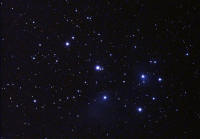 |
M45, Pleiades - Sept 23, 2006 - Last night on the
Hill the skies were nice and dark, especially after 11 when the lights went
out at the Centre of the Universe. Having stayed on the observation deck
most of the time I have to agree with Joe that the parking lot is a better
spot.
Before 11 Brenda and I wandered through a tour of doubles Gamma Andromeda,
the Double Double, the nose star of Delphinus, Albierio and Polaris. The
Double Cluster in Perseus and the ET Cluster were beautifully crisp.
After 11 I tried my first imaging for quite a while as I've just started to
acclimatize to my new telescope and mount combination. The longer tube of
the NP101 has made balancing the scope a little more challenging but I'm
starting to get the hang of it.
Here's an image of the Pleiades from this morning with some nebulosity. It's
needs some work but I can see the possibilities.
Telescope: Televue NP101is 101/5.4
Focal Length: 540mm
Sensor: Fuji Finepix S2
ISO: 800
Exposure: 120 seconds
Processing: 9 images stacked with Registar and adjusted with Adobe Photoshop
CS |
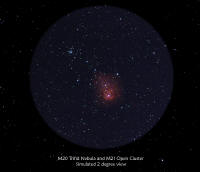 |
M20 & M21 - Summer 2006 - With the recent [bad
November] weather I'm sure most of us are reviewing our image captures from
the summer. This morning I noticed some murky images of M20 during some
sessions at Cattle Point. As I recall the seeing and transparency was less
than perfect but through some selective masking I was able to salvage a
widefield image of M20 and surprisingly a nearby neighbour M21. I'm always
happy to discover these little gems because I often ignore them in the
eyepiece when you're concentrating on a target such as M20. As a reminder
for next summer I created a 2 degree view (21mm with the NP101) of the pair
from a 30 second image at f/1.8 ISO 1600. The open cluster M21 is quite
pretty and has an interesting pattern of stars. |
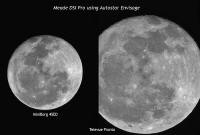 |
The Moon - May 13, 2006 - I finally had an
opportunity where the weather and desire coincided with some astro-imaging.
After accumulating some equipment over the winter I had a chance to try out
the DSI Pro and the MiniBorg 45ED.
The DSI Pro does take some getting use to with it's small chip but with some
help from Joe and a large object eg. the Moon I was able to get some images
through the MiniBorg 45ED and the Pronto. The Envisage software is quite
easy to use once you get use to the interface. I remember playing around
with this around Christmas time when I bought the DSI but I had all but
forgotten since this was not done with a real astronomical subject. |
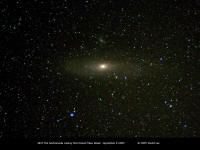 |
M31, Andromeda Galaxy - Sept 8, 2005 - Dave Bennett
and I trekked out to Island View Beach last night. When we arrived there
were dense clouds in the East. Venturing out seemed like a good idea at the
time :-( at least from the city view. Being stubborn and optimistic
astronomers we convinced ourselves to wait it out. Indeed over the next
couple of hours we caught glimpses of the sky, found M11 (Wild Duck Cluster)
and M26 both beautiful open clusters of stars. Imaging opportunities were
average to poor but it was a good opportunity to practice with my new mount.
This exposure is just over a minute set at a high sensitivity setting. I'm
getting about the same amount of light as I did the other night at the
Centre of the Universe but I will have to wait for a better night and site
to see more of M31. Unfortunately light pollution limits my exposure time.
Time to get out the light pollution filter :-)
Camera: Fuji Finepix S2
Lens: AF Nikkor 180/2.8
Sensor ISO: 1600
Exposure: 76 seconds at f/2.8 |
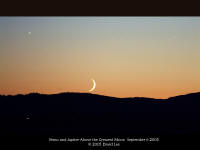 |
Venus & Jupiter with the Crescent Moon - Sept 6,
2005 - Venus and Jupiter appeared above the Crescent Moon last night forming
a right angle triangle with lights on the distant hillside. If you look
closely you can see the star Spica below Venus on the left.
Camera: Fuji Finepix S2
Lens: AF Nikkor 180/2.8
Sensor ISO: 800
Exposure: 1/6 second at f/2.8 |
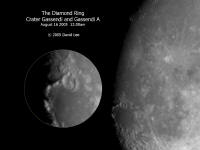 |
The Moon - Gassendi and Gassendi A (above it) -
August 15, 2005 - It forms what is commonly known as the diamond ring.
Camera: Fuji Finepix S2
Telescope: Televue Pronto 70mm / 480mm FL
Additional Optics: Eyepiece projection with 13mm Televue Plossl
Effective Focal Length: 2544mm
Exposure: 0.50 second at f/36
Sensor ISO: 400 |
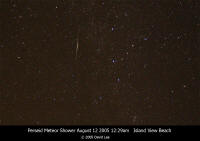 |
Perseid Meteor Shower - August 12, 2005 12:20am -
Tonight should be another good opportunity for spotting Perseids. Brenda and
I were out at Island View Beach early this morning looking up at the sky.
There were a few good ones but didn't seem to be that numerous. The skies at
Island View Beach were not as dark as at Sandy's place in Otter Point but
not bad for 15 minutes from home. The actual peak is in a few hours during
our daylight hours, so tonight should be as good as last night.
I didn't get my new mount together for last night so the exposure is from a
tripod shot ... many 30 second exposures with my 20mm lens.
Camera: Fuji Finepix S2
Lens: Nikkor 20/2.8 AF
Exposure: f/2.8 at 30 seconds
Sensor ISO Speed: 1600 |
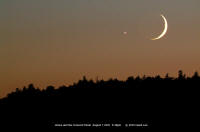 |
Crescent Moon - Venus Conjunction - Aug 7, 2005I
watched the Sun set this evening leaving a warm orangy glow where it had
dropped behind the hillside. I was still looking for Venus as the Sun set.
The bobbing of a close dragonfly pointed out the evening pair. A beautiful
crescent next to a brilliant planet. I waited as they got closer to the
hillside and snapped this picture.
Camera: Fuji Finepix S2
Telescope: Televue Pronto 480mm/6.8
Additional Optics: .8x Field Flattener for equivalent FL=384mm
Exposure: f/5.4 at 0.3 seconds
Sensor ISO: 800 |
 |
Size of Recent Solar Flares - In doing public
outreach we are often asked how big objects are that we show in our
telescopes. Well I actually asked myself this question this afternoon when
looking at some of the images from the SolarMax 40. With the help of
Photoshop's measure tool I measured the diameter of the solar disc and the
height of the large prominence we've had the pleasure to see lately. With
some simple mathematics I got an approximate size that works out to be about
5 Earth diameters. That's pretty big :-) |
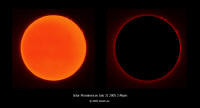 |
Solar Flares - July 31, 2005 3:46pm - More
prominences ... the previous day's large prominence was joined by a few more
and the flame-like structure had turned into a loop-like one. |
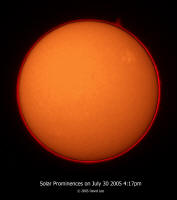 |
Solar Flares - July 30, 2005 4:17pm - The Sun has
certainly been putting on a show with the large prominence near Sunspot 792.
The morning sighting yesterday by the Red Barn was just a teaser for an
afternoon of imaging using successful and less than successful techniques. I
finally settled on using the SolarMax 40 on my alt-az mount. The exposures
ranged from 1/500 second for the face of the Sun to 1/30 second for the
prominences. The image is a composite of the 1/350 second frame and the 1/60
second frame. The face frame was adjusted for detail and colour. |
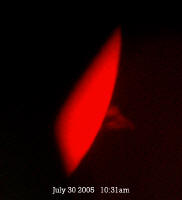 |
Solar Flare - July 30, 2005 10:31am - This morning
there was a huge solar flare on the edge of the Sun. I took a crude afocal
image with the S2 and the SolarMax. |
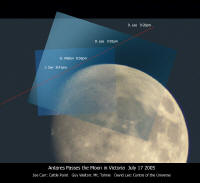 |
Antares Grazes the Moon - July
17, 2005 - Using images taken by
Joe Carr,
Guy Walton and my own, I've traced the path of Antares last night. I
manually merged the images so registration can be improved but it does show
the progress of the movement and how rapidly it moved. |
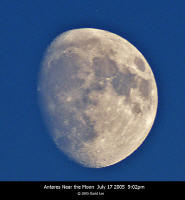 |
Antares Grazes the Moon - July
17, 2005 9:02pm - From the deck of the Centre of the
Universe we watched Antares appear as merely a glint in the evening sky
right next to the Moon. As night approached it flickered in the atmosphere
offering hints of orange. The view through the telescope was much more
impressive, so I'm glad I was sensible and looked through the eyepiece as
well :-).
Camera: Fuji Finepix S2
Telescope: Televue Pronto
Sensor ISO: 400
Exposure: 1/350 second f/6.8 |
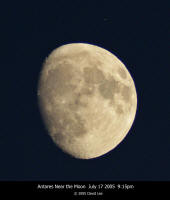 |
Antares Grazes the Moon - July
17, 2005 9:02pm - a darker sky version of the above
image. |
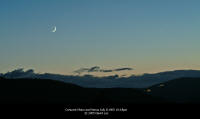 |
The Moon and Venus - July 8, 2005 - Friday night I
had hoped to photograph the Crescent Moon and two planets, Venus and
Mercury. Unfortunately Mercury was behind the hillside so I only managed to
get two of the objects. I was lucky to get even this as it was raining just
20 minutes before. As the sky got darker the earthshine on the Moon was
easier to capture. The Moon was 6.75% lit and almost 3 days from New Moon.
It's always a challenge to capture the earthshine without enlarging or
bloating the crescent too much because of the extreme difference in
exposure.
Camera: Fuji Finepix S2
Sensor ISO: 400
Lens: AF Nikkor 35-70/2.8 Zoom set at 70mm, image cropped
Exposure: f/4 at .5 second |
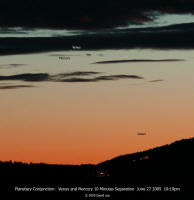 |
Planetary Conjunction - Venus-Mercury-Saturn - June
27, 2005 10:19pm, from the old 16" site on Observatory Hill. It turned
out to be a beautiful evening in spite of the cloudy afternoon.
Camera: Fuji Finepix S2
Sensor: ISO 400
Lens: 105/2.5 Nikkor Manual
Exposure: 1/6 second at f/4
481k QuickTime Movie of Mercury and Venus setting behind the hill. |
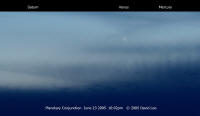 |
Planetary Conjunction - Venus-Mercury-Saturn - June
23, 2005 10:02pm, old 16" site on Observatory Hill. Tonight was a bit
of challenge but Venus, Mercury and Saturn made themselves available for yet
another planetary portrait. The wispy dark clouds below looked more like an
ocean than the sky.
Camera: Fuji Finepix S2
Lens: 105mm/2.5 Nikkor Manual
Sensor ISO: 400
Exposure: f/4 at 1/8 second |
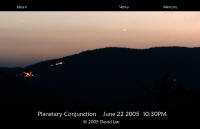 |
Planetary Conjunction - Venus-Mercury-Saturn - June
22, 2005 10:30pm, old 16" site on Observatory Hill. A group of RASCals
waited patiently for the Sun to set under the hills. Venus popped up first,
then we spotted Mercury and Saturn. Jupiter was almost forgotten as we
focused on the trio closely packed along the horizon line. Camera: Fuji
Finepix S2
Lens: 105mm/2.5 Nikkor Manual
Sensor ISO: 400
Exposure: f/4 at 1.5 seconds |
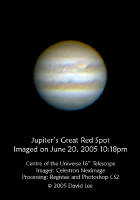 |
Jupiter's Great Red Spot - June 20, 2005 10:18pm at
the Center of the Universe using the 16" telescope and a Celestron Neximage imager.
The seeing was fairly steady tonight and as
JupSat
Pro displayed the view with the Great Red Spot (GRS) I knew I had to
image the planet's famous storm area. I've re-processed the image of
Jupiter with the Great Red Spot. The spot is much more apparent. Ah, the
wonders of re-processing your original capture footage, you can do it again
and again ... at least until you're bored :-) |
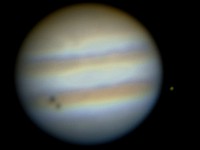 |
Jupiter Double Shadow transit -
June 8, 2005 10:02pm at the Center of the Universe using the 16"
telescope and a Celestron Neximage imager. Viewing the double transit
tonight was sketchy but Joe Carr, some
Centre of the Universe guests and myself watched Jupiter appear and reappear
out of the clouds. The seeing was poor but again I put the Neximage webcam
on the 16" to see what it could capture. The video was murky as it was on
Monday night. The Registax software made some sense of the mushy viewing
conditions. You can see the moon Europa off to one side with two shadows on
the opposing side. Io's shadow is next to Europa's. I'm not sure of the
order of the shadows, though the Sky and Telescope web article describes
Europa's shadow appearing first. The exposure of the planet is quite
different than for the moons so I did have to dodge Europa so you could see
it better. |
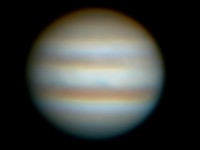 |
Jupiter -
June 6, 2005 10:02pm at the Center of the Universe using the 16"
telescope and a Celestron Neximage imager. In spite of the poor seeing
last night I couldn't resist experimenting with the Neximage imager I just
got from Brian. The webcam actually received first light the previous night
but I was having problems with my mount so off I went to the Centre of the
Universe. The 16" telescope was already cooling when I arrived at 8:30pm. We
waited until it got dark and then got Jupiter in the telrad. Jupiter was
swimming in a pool of turbulence, certainly not the night for serious
imaging. The selective processing of the Registax software worked it's magic
in moments bringing out more detail than in the original video capture. I
can see there's great potential here and why most amateurs have chosen the
webcam route for planets. Thanks Ian and the rest of the staff at the Centre
of Universe for some time on the 16". |
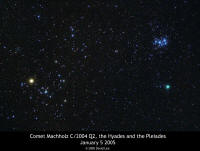 |
C/2004
Q2 Comet Machholz, the Hyades & the Pleiades
Jan 5, 2005I made another trek to Otter Point last night though there
was light haze when I arrived it was clear enough. Not as good as Monday
however. As Sandy and I discussed, Monday the sky was definitely blacker �
inkier.
I do get a chuckle when people compliment me on my compositions � I can�t
see through the viewfinder so I just point the camera in the general
direction. Last night I was armed with a Rigel Starfinder strapped to the
camera body, actually attached to an accessory shoe with double-sided tape.
Trust me I tried the rubber bands and it didn�t stay properly. Thanks Cassie
for putting it aside for me today. A mini version of a Telrad it works very
well and allows me to place that familiar red bullseye on the area of the
sky I want (for you astronomers in the crowd) and have my camera pointing in
the same direction. With the Rigel Starfinder I was able to point a little
bit more accurately than usual. Ask Brenda and Sandy sometime about my
frustration in framing these shots eg. on Monday night.
I barely missed the trees again � but I did miss them and what I cropped out
you won�t miss J.
Camera: Fuji Finepix S2 Pro
Lens: 50mm/1.8 Manual Nikkor
ISO Setting: 1600
Exposure: f/3.5 for 112 seconds |
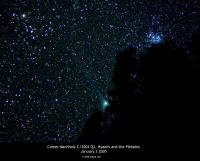 |
C/2004
Q2 Comet Machholz, the Hyades & the Pleiades
Jan 3, 2005Well, Sandy was right the Comet is definitely worth seeing
from Otter Point. What a spectacular view it was! The Hyades, Comet and the
Pleiades formed a beautiful triangle in the sky. I was finally able to
capture one of the tails of the Comet. No Orion Skyglow LPR filter
necessary. Poor positioning of the mount didn�t leave me much wiggle room
before the Comet headed for the trees. It was freezing out and Brenda and I
had to warm up inside before breaking down the equipment. Technical problems
with the mount continue to plague me but I hope to resolve them in the next
few days. The Comet continues to shuttle across the sky getting closer and
closer to the Pleiades. According to the weather prediction, Wednesday may
be the last night before rain sets in on Thursday and Friday so we may miss
the closest approach to the Pleaides.
Camera: Fuji Finepix S2 Pro
Lens: 50/1.8 Manual Focus Nikkor
ISO Setting: 1600
Exposure: f/2 at 80 seconds
Piggy-backed on C8 Super Polaris Mount |
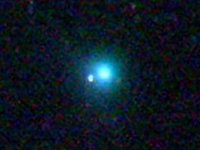 |
C/2004
Q2 Comet Machholz & the Pleiades
Jan 2, 2005It was quite cold tonight but I couldn�t resist getting
out and looking at the Comet. It�s getting very close to the Pleiades, not
optimum position yet but you never know if the weather will change for its
closest position. It was right next to the mag 6.88 star HIP 17617.
Technical Info:
Camera: Fuji S2 Finepix
Lens: 50/1.8 Manual Nikkor
Filter: Orion Skyglow
ISO Setting: 1600
Exposure: f/2 at 64 seconds
Piggy-backed on a C8 / Super Polaris Mount |
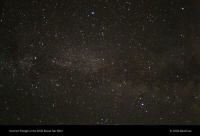 |
The Summer Triangle
2004 RASCALs Star Party
Sept 18, 2004
Evidence of clear skies at the Star Party � at least for a while.
Camera: Fuji S2
Lens: 16mm AF Nikkor (cropped)
Exposure: 30 seconds at f/2.8 untracked
Despite the weather it was fun to get together with everyone. Linda�s talk
was well worth it.
David |
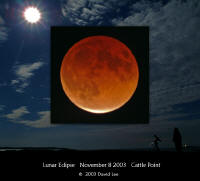
Lunar Eclipse
Nov 8, 2003
Cattle Point, Victoria
The lunar eclipse from September 1996 was photographed prime
focus using a Televue Pronto on a Super Polaris mount. A 2x Tamron
AF teleconvertor was used to increase the size of the image. The
effective aperture of the assembly was approximately f/14. The
film used was Fujicolor 800 Super G Plus. Exposures ranged from
1/250 second to 15 seconds. Individual images were composited
with Photoshop.
The identical setup as above was used for the partial lunar
eclipse in March 1997.
Comet Hale-Bopp was photographed at the DAO. A 35mm camera
with 105mm/2.5 lens was piggybacked and guided on the Pronto/Super
Polaris system. Exposure was 8 minutes at f/2.5 with Orion Skyglow
filter. Color correction was done to remove the magenta cast normally
associated with the filter.
David's June 2002 Image
Gallery

September 26 1996 Total Lunar
Eclipse Victoria BC
|
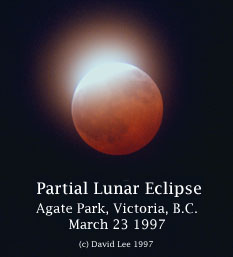 March 23 1997
Partial Lunar Eclipse Victoria BC
|
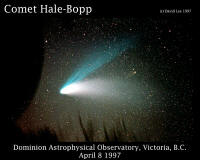
April 8 1997 Comet
Hale-Bopp Victoria BC |
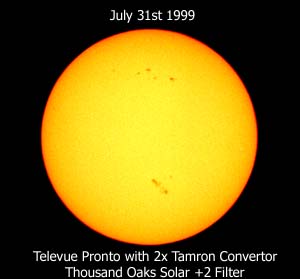
July 31 1999 Sunspots Victoria BC |

August 29, 2003 - Mars
- Centre of the Universe, Victoria BC |
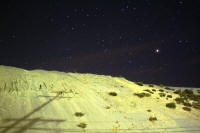
Sept 22, 2003 Mars over the Colwood gravel pit |
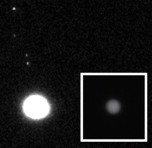 Video Capture of Jupiter &
Moons - David Lee uses video to increase his chances of
capturing usable images of Jupiter. Video Capture of Jupiter &
Moons - David Lee uses video to increase his chances of
capturing usable images of Jupiter. |
|
|
Images are ©David Lee: David_Lee@telus.net